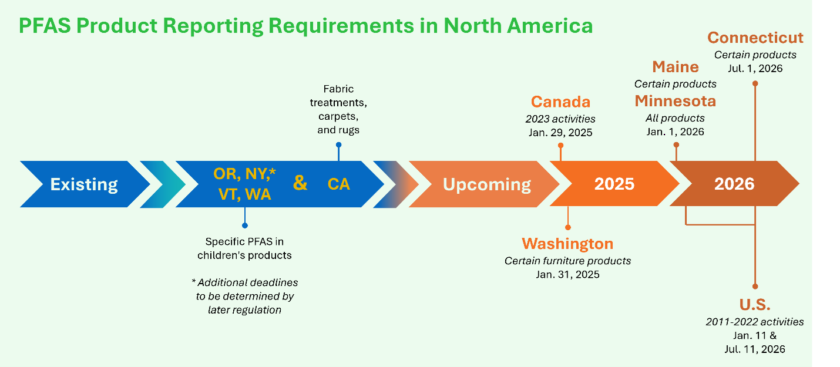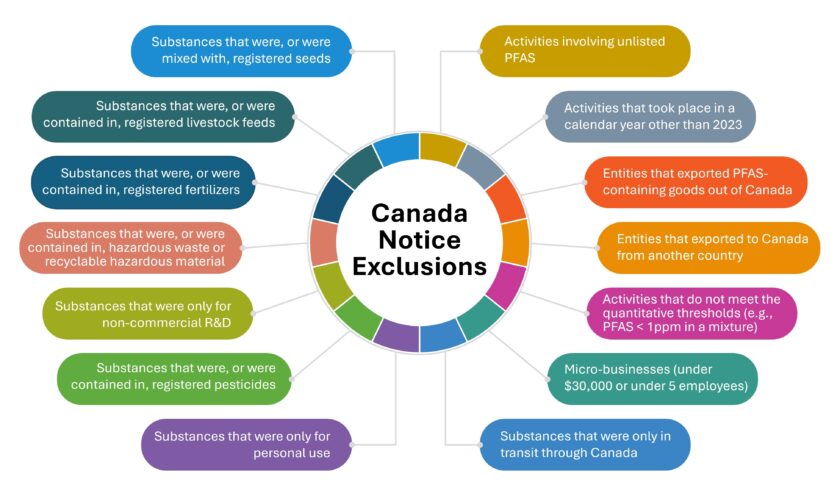Global PFAS Regulation Quickens with New Canada Reporting Obligation

Newsletter Articles
PFAS regulation is increasing not only in the United States, but globally. Manufacturers and exporters who sell into multiple markets must comply with an increasingly complex and changing set of rules, and face exposure to liability and penalties for failing to do so.
For example, just a month ago, Environment and Climate Change Canada (“ECCC”) announced a Notice that sets backward-looking reporting requirements for certain manufacturers and importers of PFAS or certain PFAS-containing goods with a compliance deadline of January 29, 2025.[1] While similar in some respects to the U.S. Environmental Protection Agency’s (“EPA’s”) PFAS Reporting Rule under the Toxic Substances Control Act (“TSCA”),[2] there are also significant differences, not the least of which is the very imminent reporting deadline.
Thus far in North America, several U.S. states, EPA, and now Canada have announced PFAS reporting requirements.[3] PFAS regulations are arising on other continents as well—Japan and the E.U., for example, each require PFAS reporting of some kind.[4] EPA’s PFAS Reporting Rule is the most ambitious in scope and includes an 11-year “look back” reporting period (2011-2022).[5] The ECCC Notice employs an entirely different framework of covered activities and exemptions and has a look back period of only one year (2023). And while TSCA reporting was very recently pushed back to 2026,[6] the Canada deadline is in just four months.
Newsletter Articles
Authors
Related Services and Industries

What is the Purpose of the Notice?
ECCC is imposing the reporting requirements to assess whether the several hundred PFAS subject to reporting are “toxic or are capable of becoming toxic” and to inform the agency’s future decisions on whether to regulate those substances.[7] Notices like this are promulgated under Section 71 of the Canadian Environmental Protection Act of 1999 (“CEPA”),[8] a pollution control statute that operates in part to prevent the release of substances deemed “toxic” by the ECCC.[9]
Information gathering under Section 71 is often a precursor to further regulation. The two most well-studied PFAS—PFOS and PFOA—as well as long-chain perfluorocarboxylic acids (“LC-PFCAs”), and their salts and precursors, are already listed as toxic substances under CEPA.[10] Their manufacture, use, sale, and import has been prohibited since 2016, with several exceptions, including for use in aqueous film-forming foams for firefighting.[11] Canada announced plans in 2021 to address PFAS as a class, and published a draft “State of PFAS” report in 2023, which it updated in July 2024.[12] The report recommended a “precautionary, class-based approach to addressing PFAS” and found that “concerns identified” for certain well-studied PFAS are “more broadly applicable to other PFAS than previously believed.”[13] This call for information may be a prelude to the broader class-based regulatory approach contemplated in the State of PFAS report.
Which PFAS are Covered?
The Notice creates reporting requirements covering 312 PFAS. Among the thousands of PFAS chemicals, the list includes only PFAS that ECCC knows or expects are present in Canadian commerce.[14]
EPA’s PFAS Reporting Rule under TSCA, by comparison, covers any PFAS meeting the agency’s broad structural definition of PFAS.[15] For ease of implementation, EPA has similarly provided a list of hundreds of PFAS that would qualify for reporting; however, its coverage is far broader than that list alone.[16]
Reporting Manufacturers and Importers
The ECCC Notice applies to entities that manufactured or imported any listed PFAS, used a listed PFAS to manufacture a good domestically, or imported goods[17] containing listed PFAS during the 2023 calendar year.[18] The Notice applies equally to industrial and consumer goods.
ECCC has identified several specific product categories where a lower threshold of PFAS content will trigger reporting obligations. These specifically listed manufactured items include: children’s products, products intended for skin or other bodily contact, food contact products, apparel, bedding, furniture, flooring, and other manufactured items.[19] The Notice requires reporting when manufactured or imported goods exceed certain concentration or quantity thresholds of the 312 listed PFAS substances.
Generally, information must be reported for each covered substance, facility, and activity or good. Persons who must report include those who:
- Manufactured more than 1000g (1kg) of a listed PFAS.
- Imported more than 10g of certain listed PFAS, or more than 100kg of other listed PFAS,[20] either as a substance alone or at a concentration of at least 1ppm in a mixture, product, or a specifically listed manufactured item.
- Imported over 100kg of any listed PFAS at a concentration of at least 1ppm in any non-listed manufactured item.
- Used—in the manufacture of a mixture, product, or manufactured item—over 10g of a listed PFAS, whether the PFAS was alone or at a concentration of at least 1ppm.
Exemptions
The Notice includes a limited set of exemptions. Entities who only exported otherwise covered substances or goods into or from Canada, but did not import them to Canada, are not required to report. For example, a U.S. company’s export of a PFAS-containing textile to Canada does not subject the company to reporting—rather, the importer into Canada would hold the obligation. Likewise, a Canadian company whose only activity in 2023 was to export PFAS-containing textiles to the U.S. need not report. Exemptions also exist for: substances or goods merely “in transit” through Canada (i.e., Canada was neither the origin nor the destination); substances or goods for personal or laboratory use only; hazardous wastes and hazardous materials in compliance with applicable hazardous material regulations; and substances and goods that were registered under certain pesticide, fertilizer, and agriculture-related statutes.[21] It also excludes micro-businesses with fewer than five employees or under $30,000 CAD gross revenue.[22]

Reportable Information
ECCC will require reporting entities to submit a variety of information through its online portal.[23] Reportable information falls into several categories, including: (1) identification information (i.e., data about the company and person submitting the report);[24] (2) information about the facility that engaged in the covered activities, and a description of policies in place to prevent and mitigate releases;[25] (3) the PFAS involved, and the quantity thereof;[26] (4) information on the goods that were manufactured or imported containing the PFAS, including the purpose of the PFAS, the concentration of the PFAS, and the intended use of the good;[27] and (5) technical chemical data on the PFAS involved.[28]
Entities that determine they are not required to report still face a compliance decision. Such entities may voluntarily submit information regarding any PFAS-related activity they have been engaged in through a Declaration of Stakeholder Interest (“SHI”) or merely inform ECCC that they are not required to report via a Declaration of Non-Engagement (“DNE”).[29] The SHI does not require specific information to be reported, but ECCC’s Guidance suggests that an SHI “may include” information on non-listed PFAS, activity from another calendar year, or about activity under the reporting thresholds.[30] Neither a SHI nor a DNE is required: the Notice only requires a response from entities that meet the reporting requirements. However, it may be advantageous to submit relevant information to ECCC if an entity is uncertain whether it is in fact required to respond to the Notice. An entity that fails to respond could incur penalties.[31] The decision whether to share voluntary information with ECCC is legally complex and requires fact-specific analysis for each entity’s situation.
Protecting Confidential Business Information
Submitting information to ECCC in response to the Notice could subject it to publication. ECCC has published summaries of data from past Section 71 notices online, but its reports typically omit data identifying specific businesses.[32] However, the Notice allows anyone who reports information to submit a written request that the information be treated as confidential.[33] ECCC guidance on submitting CBI requests directs submitters to narrowly specify what data constitutes CBI and provide a rationale for its confidentiality. Valid potential CBI rationales include that the information is: (1) a trade secret; (2) of a financial, commercial, scientific or technical nature and treated confidentially by the submitter; (3) could result in competitive disadvantage or financial loss to the submitter if disclosed; or (4) could interfere with the submitter’s contracts or negotiations.[34]
Due Diligence Standard
Entities subject to the Notice must conduct due diligence to gather the information that will inform their response. Pursuant to CEPA Section 71, reporting is limited to information “that may be in the person’s possession or to which the person may reasonably be expected to have access.”[35] The guidance provides examples of the type of information generally expected from different categories of companies:
- Companies involved in the commercial production of substances, mixtures, products, or manufactured items should have “access to quantities and concentrations of substances contained in items.[36]
- Importers should have access to “import quantities and supporting documentation such as Safety Data Sheets (SDS), and product data sheets” containing information regarding “the composition of imported items.”[37]
Companies must contact their suppliers as well. In some cases, a company may have very little access to information about the chemical content of the goods with which it engages. Companies who “know or suspect that PFAS is present in [their] goods” are directed to contact suppliers to obtain “the necessary information to assist in determining whether [the company] meet[s] the requirements of the notice,” and if so, to obtain “the necessary information required to respond to that notice.”[38] ECCC provides a template letter for Canadian companies to request the necessary information from foreign suppliers.[39] Contact with suppliers is not explicitly mandatory, but ECCC has indicated that failure to do so when necessary information may be in the supplier’s possession would not meet the CEPA due diligence standard. In some cases, the supplier may not possess or may not provide the information the company needs. The response submission portal provides the opportunity to indicate if certain data was “not reasonably accessible.”[40]
By comparison, EPA’s TSCA PFAS Reporting Rule sets a “known or reasonably ascertainable” standard for due diligence. That standard covers records in the entity’s possession as well as things someone in the reporter’s position should know.[41] EPA has clarified that this requirement does not mandate new testing, chemical analyses, or surveying. Nonetheless, companies may be required to engage with key suppliers to obtain the information necessary to report. Critically, for those entities that do not know the chemical inputs of their products, supplier outreach may be a requirement to demonstrate compliance with the due diligence standard.
Enforcement and Penalties
Entities that fail to respond to the Notice despite being subject to it, or that provide information that is negligently false or misleading, could face substantial financial penalties. Under CEPA, penalties for entities that violate the requirements of a Section 71 notice range from up to $25,000 CAD for an individual after summary proceedings to up to $1 million CAD for repeat offenses by a large corporation.[42]
By When Must Entities Comply?
Information must be submitted to ECCC by January 29, 2025.[43] Covered entities may request additional time as needed by submitting a written request prior to the reporting deadline.[44]
Next Steps
Given the short timeline for gathering the information required to satisfy ECCC’s Notice and the various U.S. state and federal reporting regimes in play, consumer product manufacturers and importers will need to begin the process of conducting due diligence, gathering data, planning to substantiate CBI protection of their reportable information, and assuring the completeness of the data submitted. Consistent reporting across these different jurisdictions will be essential to minimize enforcement or litigation risk.
Please contact members of Marten’s Consumer Products Practice, including James Pollack, Isabel Carey, Aidan Freeman and Zachary Zahner if you have questions regarding compliance with federal, state, or Canadian PFAS reporting rules.
[1] Dep’t of the Environment, Notice with Respect to Certain Per- and Polyfluoroalkyl Substances (PFAS), 158 Can. Gazette, Supplement (July 27, 2024) [“ECCC Notice”].
[2] Toxic Substances Control Act Reporting and Recordkeeping Requirements for Perfluoroalkyl and Polyfluoroalkyl Substances, 88 Fed. Reg. 70,516 (Oct. 11, 2023) (to be codified at 40 C.F.R. pt. 705) [“TSCA PFAS Reporting Rule”].
[3] See Id.; ECCC Notice; Or. Admin. R. § 333-016-2020 (including PFOS on list of chemicals of high concern to children under Or. Rev. Stat. § 431A.253 et seq. (“Oregon Toxic-Free Kids Act”)); N.Y. Env’t Conserv. L. § 37-0905 (listing PFOA and PFOS on list of toxic chemicals in children’s products); N.Y. Dept. of Env't Conserv., Toxic Chemicals in Children's Products, https://dec.ny.gov/environmental-protection/help-for-businesses/toxic-chemicals-in-childrens-products (last visited Sep. 6, 2024) (discussing pending implementation of portions of the N.Y. Environmental Conservation Law related to children's products containing PFAS); 18 Vt. Rev. Stat. § 1773 (listing PFOS as a chemical of high concern to children); Wash. Admin. Code § 173-334-130 (listing PFOA and PFOS as chemicals of high concern to children); Cal. Dep’t of Toxic Substances Ctrl., Effective July 1, 2021: Carpets and Rugs with Perfluoroalkyl or Polyfluoroalkyl Substances (PFAS), https://dtsc.ca.gov/scp/carpets-and-rugs-with-perfluoroalkyl-and-polyfluoroalkyl-substances-pfass/ (last visited Sep. 4, 2024); Wash. Admin. Code § 173-337-110 (requiring reporting for certain PFAS containing furniture); Me. Pub. L. 2024, c. 630 (requiring reporting for PFAS-containing products where the use of PFAS is currently unavoidable), https://www.mainelegislature.org/legis/bills/getPDF.asp?paper=SP0610&item=3&snum=131 (last visited Sep. 4, 2024); 2023 Minn. Stat. 116.943 (requiring reporting for all PFAS containing products by Jan. 1, 2026); 2024 Conn. Pub. Act No. 24-59 at 6–7 (S.B. 292 § 1(b)(1)).
[4] Japan Nat’l Inst. of Tech. and Evaluation, Substances Under the Chemical Substances Control Law – Class I Specified Chemical Substances, https://www.nite.go.jp/chem/jcheck/list6.action?category=211&request_locale=en (last visited Sep. 4, 2024); E.U. Industrial Emissions Directive, Doc. 32010L0075 (Apr. 2024 version), https://eur-lex.europa.eu/legal-content/EN/TXT/?qid=1404121608038&uri=CELEX:32010L0075 (last visited Sep. 4, 2024).
[5] James Pollack, Victor Xu & Emma Lautanen, New EPA PFAS Reporting Rule Covers Thousands of Products, Marten Law (Oct. 30, 2023), https://martenlaw.com/news/new-epa-pfas-reporting-rule-covers-thousands-of-products.
[6] The original deadlines of May 8 and November 12, 2025 were pushed back by about eight months after EPA published a notice that it was having difficulties building the software to accept reporting in September 2024. The new deadlines are January 11 and July 11, 2026. U.S. Env’t Prot. Agency, Perfluoroalkyl and Polyfluoroalkyl Substances (PFAS) Data Reporting and Recordkeeping under the Toxic Substances Control Act (TSCA) – Change to Submission Period and Technical Correction (published in Federal Register on Sep. 5, 2024), public inspection document available at https://public-inspection.federalregister.gov/2024-19931.pdf.
[7] ECCC Notice at 45–46; ECCC Guidance Manual at 5.
[8] S.C. 1999, c. 33, s. 71.
[9] S.C. 1999, c. 33, s. 90.
[10] ECCC, Toxic Substances List: Schedule 1 (updated May 12, 2021), https://www.canada.ca/en/environment-climate-change/services/canadian-environmental-protection-act-registry/substances-list/toxic/schedule-1.html (last visited Sep. 4, 2024).
[11] Prohibition of Certain Toxic Substances Regulations, 2012, SOR/2012-285, https://laws-lois.justice.gc.ca/PDF/SOR-2012-285.pdf (last visited Sep. 4, 2024).
[12] ECCC, Updated Draft State of Per- and Polyfluoroalkyl Substances (PFAS) Report (July 2024), https://www.canada.ca/en/environment-climate-change/services/evaluating-existing-substances/updated-draft-state-per-polyfluoroalkyl-substances-report.html#toc85 (last visited Sep. 4, 2024).
[13] Id.
[14] ECCC, Guidance Manual for Responding to the Notice with Respect to Certain Per- and Polyfluoroalkyl Substances (PFAS), at 5 (July 2024) [“ECCC Guidance Manual”], https://www.canada.ca/content/dam/eccc/documents/pdf/pded/s71-pfas/Guidance%20manual_s71%20PFAS.pdf (last visited Sep. 4, 2024).
[15] TSCA PFAS Reporting Rule at 70,517–18.
[16] See EPA, TSCA Section 8(a)(7) Reporting and Recordkeeping Requirements for Perfluoroalkyl and Polyfluoroalkyl Substances (last updated May 24, 2024) (click on file “Public List of TSCA PFAS for 8(a)(7) Rule”), https://www.epa.gov/assessing-and-managing-chemicals-under-tsca/tsca-section-8a7-reporting-and-recordkeeping (last visited Sep. 4, 2024).
[17] “Good” is defined as “a mixture, product or a manufactured item.” ECCC Notice at 3.
[18] Id. at 3–5.
[19] The full list is located at ECCC Notice at 3–4. Further detail is contained in the ECCC Guidance Manual, Table 1, at 9–10.
[20] ECCC Notice at 3.
[21] Id. at 5.
[22] Id. at 3.
[23] ECCC Guidance Manual at 16.
[24] Identification information includes, but is not limited to: the company’s name, address, and business number; and name and contact information for someone who may act on the company's behalf. Id. at 20.
[25] Facility information includes but is not limited to: the name and address of each facility with covered activities involving a listed PFAS; whether any known releases from the facility occurred in 2023; and a description of policies in place to prevent and mitigate releases. Id. at 21–22.
[26] Substance information includes but is not limited to: the identity of each reportable substance with which the company engaged in a reportable activity in 2023; and the quantity of the substance manufactured, imported, or used in manufacturing. Id. at 24.
[27] Information on goods includes but is not limited to: data on the type of good in which a listed PFAS was contained; data on the function the listed PFAS served in that good; a description of the concentration of the listed PFAS in each good; whether the goods were exported; and whether they were intended for commercial, consumer, or juvenile use. Id. at 27–28.
[28] Id. at 31.
[29] ECCC Notice at 46.
[30] ECCC Guidance Manual at 16.
[31] See ECCC Notice at 46; S.C. 1999, c. 33, s. 272.1.
[32] ECCC, Data Gathered Under Section 71 of the Canadian Environmental Protection Act (CEPA 1999), https://data-donnees.az.ec.gc.ca/data/substances/outreach/data-gathered-under-section-71-of-the-canadian-environmental-protection-act-cepa-1999?lang=en (last visited Sep. 4, 2024).
[33] ECCC Notice at 2; S.C. 1999, c. 33, s. 313.
[34] ECCC, Approach to Disclose Confidential Information and Promote Transparency in Chemicals Management, https://www.canada.ca/en/environment-climate-change/services/evaluating-existing-substances/approach-confidential-information-chemicals-management.html (last visited Sep. 4, 2024).
[35] S.C. 1999, c. 33, s. 71(1)(b); see ECCC Notice at 2 (reporting requirement applies to “any person described in section 2 of this notice who possesses or who may reasonably be expected to have access to” reportable information).
[36] ECCC Guidance Manual at 15.
[37] Id.
[38] Id.
[39] ECCC, Request for Information from Foreign Suppliers, https://www.canada.ca/en/environment-climate-change/services/evaluating-existing-substances/foreign-supplier-letter.html (last visited Sep. 4, 2024).
[40] See ECCC Guidance Manual at 30.
[41] 40 C.F.R. § 705.15.
[42] ECCC Notice at 46; S.C. 1999, c. 33, s. 272.1.
[43] ECCC Notice at 2.
[44] Id. at 46; S.C. 1999, c. 33, s. 71(4).
Authors
Related Services and Industries
Stay Informed
Sign up for our law and policy newsletter to receive email alerts and in-depth articles on recent developments and cutting-edge debates within our core practice areas.

